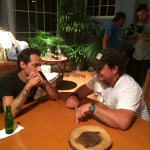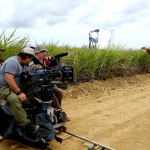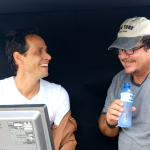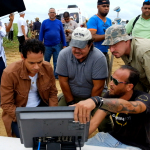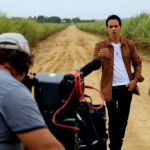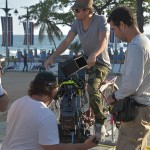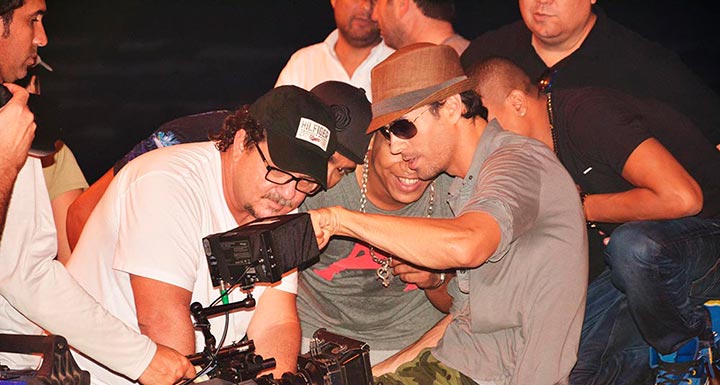
Alejandro Pérez: The Cuban video clip with Marc Anthony and Enrique Iglesias
MIAMI — For Alejandro Pérez, 2014 has been an awesome year. In January, he launched his video clip of “Bailando,” by Descemer Bueno and Gente de Zona, with the participation of Cuba’s Lizt Alfonso Ballet. It was an immediate hit on the island.
In the ensuing months, the Cuban producer directed four other versions of one of the most popular tunes worldwide. The performance by Enrique Iglesias has earned it four nominations to the Latin Grammys, in the categories of Record of the Year, Song of the Year, Best Urban Song and Best Urban Performance.
Alejandro, director of photography for the films “Havanastation” and “Conducta,” directed by filmmakers Ian Padrón and Ernesto Daranas, respectively, is visiting Miami, preparing for the next audiovisual encounters with world-renowned artists.
Little over a week ago, “Flor pálida,” by the unforgettable Polo Montañez, sung by Mark Anthony, premiered. Alejandro was behind the camera, directing this clip, which has garnered more than 8 million viewings in YouTube and promises many more.
Alejandro Pérez makes a stop in his busy schedule and shares with Progreso Weekly some of his stimulating experiences climbing the ladder of the world’s music market.
Maylín Legañoa: Alejandro, many people praise your videos and wonder what it was like to work with artists like Enrique Iglesias and Marc Anthony.
Alejandro Pérez: This was a video that we had planned long ago, even before “Bailando.” The people who work with Marc asked me to write a story on one of two songs: “Flor pálida” or “Cambio de piel.” I wrote “Flor pálida” because I really like it more.
Months went by, nothing happened, and I forgot it all. One day, when I was in New York, I got a call from Marc’s brother, Bigram, who’s also his manager, and he told me that we were going to film the video the following week, in Santo Domingo.
“I’m in New York,” I told him, and he said, “Come to the office and we’ll talk.” There, we planned everything in one week. I went directly from New York to Santo Domingo to prepare everything.
ML: Was the possibility ever discussed that this clip be filmed in Cuba, not in Santo Domingo, considering the origin of the tune and its composer, Polo Montañez?
AP: No. I thought about it, but [the filming] coincided with a break in Marc’s tour of Santo Domingo. During two days of rest, we were going to film. I didn’t know him. At no time had I met with him. I asked his manager for an interview, because I seldom film a video clip if I don’t know the artist, but the meeting never materialized.
ML: You became acquainted during the filming itself?
AP: Yes, and that weighed heavy on me. I was concerned, because he appeared in every scene. His call was for 10 a.m., and the call for his girlfriend, who plays the model in the clip, was for 9 a.m. I had been filming since 5 a.m. and was annoyed because he had not granted me an interview. That could hinder the story I had conceived, even if he knew everything he had to do. To tell you the truth, I didn’t feel well at all about that.
ML: How did the encounter go, then?
AP: Amid all that, Marc arrived but I didn’t go meet him. I continued to film and said that when his turn came he would be called up. Period. I tell you again: I was very disgusted. About 15 minutes later, Marc called me and asked me to go to his trailer. I was still annoyed, for the reason I told you, but that vanished in two seconds when Marc welcomed me and said, “Hey, papito, whazz happenin’? Tell me.”
We started to talk and I felt right at home. I relaxed and thought: everything is going to work fine. Our chemistry was perfect and right away I told him the story of the story we were going to film. He thought that it might be too ambitious for a two-day shoot, but we understood each other and he told me: “I am a soldier; I do what you tell me. That’s what I’m here for.”
I was amazed by his disposition, his laughter, his cheer and tremendous enthusiasm. After that, we constantly hugged every time we watched the filmed segments. It was truly special.
ML: Did the same happen with the filming of ‘Bailando’? How was your experience with Enrique, Descemer and Gente de Zona?
AP: With Enrique, it was different. The first time, we had a rather unpleasant experience because of problems created by the Santo Domingo producer who had been recommended to us. My production plans were not met and it was the first time I worked with Enrique.
We had met on the phone. When he saw the video of “Bailando” that I first made in Cuba, he called Descemer and told him he wanted to appear in the video. He wanted to know who the director was and asked to be put in touch with me. He called me on the phone, congratulated me and asked that he be included in the same video I had already filmed.
That was very complicated. The video had been designed one way, and he couldn’t go to Cuba. I proposed another idea. We met in his studio in Miami and made plans to film in Santo Domingo.
ML: What was the production problem in Santo Domingo?
AP: I had to film with a special camera that I had requested, with certain characteristics. When the time came for the shoot, the camera was not there, and, because I was the director, I was responsible for everything. I felt bad about what other people might think of me.
Nothing bad happened, but I can assure you that it was one of the most tense moments in my life, because of what that job meant to me. A crisis occurred in the middle of the set, but at the end everything resolved favorably.
That’s where we came up with the idea of a street scene, which hadn’t been scripted. Without a permit, without authorization, we blocked off one of Santo Domingo’s main streets and filmed the scene on the fly. Unquestionably, that is one of the most important scenes in the clip and pumped much life into it. That’s how it is with Enrique. After that, well, you can see the result.
ML: The fact is that it has had nearly 500 million viewings on YouTube. It is said that ‘Bailando’ is the Spanish-language song most listened to in history, surpassing the success of ‘Macarena’ in the 1990s. I find it interesting that four versions of it were made. Why?
AP: That’s true. We did the first version in Havana, then with Enrique, then with [Jamaican singer] Sean Paul, then with Luan Santana, a Brazilian singer, and later a version that we did for the World Cup soccer tournament. We all behaved as if we had been lifelong friends — and ended up becoming longtime friends.
ML: How is that relationship?
AP: [LAUGHS] Some times we call each other, especially he does. He calls me at 3 or 4 in the morning and we cook up ideas for projects. I’m usually awake at that time because we’re partners in other projects, like the one we’re preparing.
ML: What’s that project all about? Give Progreso Weekly an exclusive.
AP: We’re going to film that clip next week. The leading characters are Enrique and Pitbull; the tune comes from an Iglesias recording. It’s one of the most difficult videos I’ve ever done. I’m going to work with 1-foot puppets. One is Enrique, the other is Pitbull.
It’s a romp about what usually happens on the stage with the paparazzi. In the clip, the puppets dance, interact with Barbies, play. It’s crazy but amusing. From the point of view of expression, it will be difficult because I need to convey in gestures the feelings that I want to project.
We’ll see. I have one week’s rehearsals with the puppets, when I must stage the choreography and get what I really need for the clip. That’s why I say it’s one of my most difficult projects: I have to animate something that’s inanimate.
ML: Have you thought about bringing the two artists to Cuba?
AP: They’re more anxious to visit Cuba than you or me, and they’ve told me so. For Marc Anthony and Enrique, it’s a dream, a dream that they’ll turn into reality. All I can tell you is that they’re going to do it before they leave the stage. I’ll be witness to that.
ML: I’m sure that Alejandro Pérez has not changed since meeting Luis Enrique, Enrique Iglesias and Marc Anthony. Is simplicity still one of your qualities?
AP: You can be sure of that. That’s the way I am. In fact, it worries me that, in addition to many commitments here, I have others in Cuba. I don’t want to disappoint anyone and that causes me to work three times as hard. That tells you that I can never forget my people. They’re worth more to me than everything in the world.
Photos courtesy of Alejandro Pérez


